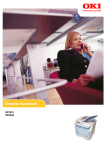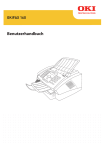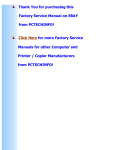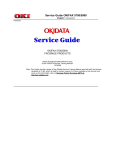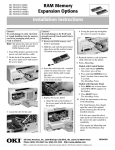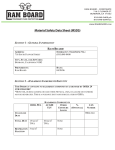Download Okidata User's Guide OKIFAX 5750/5950 Material Safety Data Sheet
Transcript
User's Guide OKIFAX 5750/5950 Chapter L Material Safety Data Sheet Material Safety Data Sheet OKIFAX 5700/5750/5900/5950 Dual Line Toner, P/N 40815606 - MSDS #58336401 For more information, contact Okidata at: OKI DATA 2000 Bishops Gate Blvd. Mount Laurel, NJ 08054 Emergency Information: Call 1-800-OKIDATA (1-800-654-3282), U.S. and Canada only Emergency First Aid Procedures Toner swallowed (ingested) Dilute by giving two glasses of water and induce vomiting by administering Syrup of Ipecac (follow manufacturer's instructions). Seek medical attention. NEVER give anything by mouth or attempt to induce vomiting in a person who is unconscious. Toner inhaled Remove person to fresh air. Seek medical attention. Toner gets in the eyes Flush eyes with large quantities of cool water for 15 minutes, keeping the eyelids open with fingers. Seek medical attention. Small amounts of toner on skin or clothing can easily be removed with soap and cold water. Hot water makes toner harder to remove. Hazardous Ingredients Styrene-Butyl Acrylate Copolymer (91% by weight) CAS# 25767-47-9 OSHA TWA 15 mg/m3 for total dust ACGIH TLV 10 mg/m3 for total dust Carbon Black (5-7% by weight) CAS# 1333-86-4 OSHA TWA 3.5 mg/m3 ACGIH TLV 3.5 mg/m3 Polypropylene (less than 3% by weight) CAS# 9003-07-0 OSHA TWA 15 mg/m3 for total dust ACGIH TLV 10 mg/m3 for total dust Amorphous Fumed Silica (less than 1% by weight) CAS# 67762-90-7 OSHA PEL 15.0 mg/m3 for total dust ACGIH TLV 10.0 mg/m3 for total dust This product is not regulated under Section 313 of SARA, Title III. Physical Data Melting Point: 110°C (230°F) Boiling Point: Not applicable Vapor Pressure: Not applicable Vapor Density (Air=1): Not applicable Evaporation Rate (Butyl Acetate=1): Not applicable Specific Gravity (H 2 O=1): 1.15 Solubility in water: Negligible Appearance and odor: Black granules, no odor Fire and Explosion Hazard Data Flash Point (Method Used): Not applicable Flammable Limits Lower Explosive Limit: Not applicable Upper Explosive Limit: Not applicable Extinguishing Media: Water, CO2, Dry Chemical, or Foam Special Fire Fighting Procedures: Do not use methods that may create a dust cloud, such as high pressure water and/or steam Unusual Fire and Explosion Hazards: Organic components decompose at 200-455°C (392-851°F). Material may explosively combust when finely suspended in air. Thermal decomposition of organic components may result in release of oxides of carbon and nitrogen. Health Hazards Data Routes of Entry: Inhalation, Ingestion, Eyes, Skin. 1 Styrene-Butyl Acrylate Copolymer Subcutaneous implantation of polymeric styrene powder in rats has induced tumors at the site of implantation. 2 Carbon black (Group 2B "Possible Carcinogen"; IARC) Overexposure to carbon black is associated with causing irritation, conjunctivitis, and corneal hypoplasia of the eyes; minor irritation and eczema of the skin; and irritation and bronchitis. Long-term inhalation exposure may be associated with causing lung cancer. 3 Polypropylene (Group 3 "Not Classifiable"; IARC) Subcutaneous implantation of polypropylene powder in rats has induced tumors at the site of implantation. 4 Amorphous Fumed Silica (Group 3 "Not Classifiable"; IARC) Overexposure to amorphous silica has been associated with causing irritation of the lungs and pneumoconiosis. Long-term inhalation exposure may be associated with producing tumors in laboratory animals. Reactivity Data Stability: Stable Polymerization: Will not occur. Hazardous Decomposition Products: Thermal decomposition may result in release of oxides of carbon and nitrogen. Temperature: Do not expose to temperatures above 200°C (392°F). Incompatibility: Avoid exposure to strong oxidizers. Spill Cleanup and Disposal Spill Cleanup Small Spills 1 Remove sources of ignition. 2 Clean up spill with wet cloth. Large Spills 1 Remove sources of ignition. 2 Wear protective gear: respirator, rubber gloves, goggles (see below) 3 Clean up spill with scoop, being careful not to generate a lot of dust. Waste Disposal Follow appropriate federal, state and local regulations. Safe Handling and Use Respiratory Protection: Not normally required. For large spills, use NIOSH-approved full face-piece respirator with HEPA cartridge during cleanup. Protective Gloves and/or Eye Protection: Not normally required. For large spills, use rubber gloves and chemical worker's goggles during cleanup. Ventilation: Outside of normal ventilation, not normally required. Other Protective Equipment and/or Hygienic Practices: None Special Precautions Precautions for Handling or Storage: Protect from high heat. Avoid making dust. Other Precautions: None To the best of the manufacturer's knowledge, the information contained herein is accurate. However, neither the manufacturer, nor any of its affiliates, make any representations or warranties (expressed or implied), nor assumes any liability (including liability for any direct, incidental, consequential, or other damages) with respect to the accuracy or completeness of the information contained herein. Such information may be (without limitation) invalid if the specified material is used in combination with another, in a particular process, or under unusual conditions. Determination of suitability of any material for any given purpose is the sole responsibility of the user who assumes all risk and responsibility therefor. All materials may present unknown hazards and should be used with appropriate caution. The manufacturer cannot and does not guarantee that the hazards described herein are the only ones that exist.




